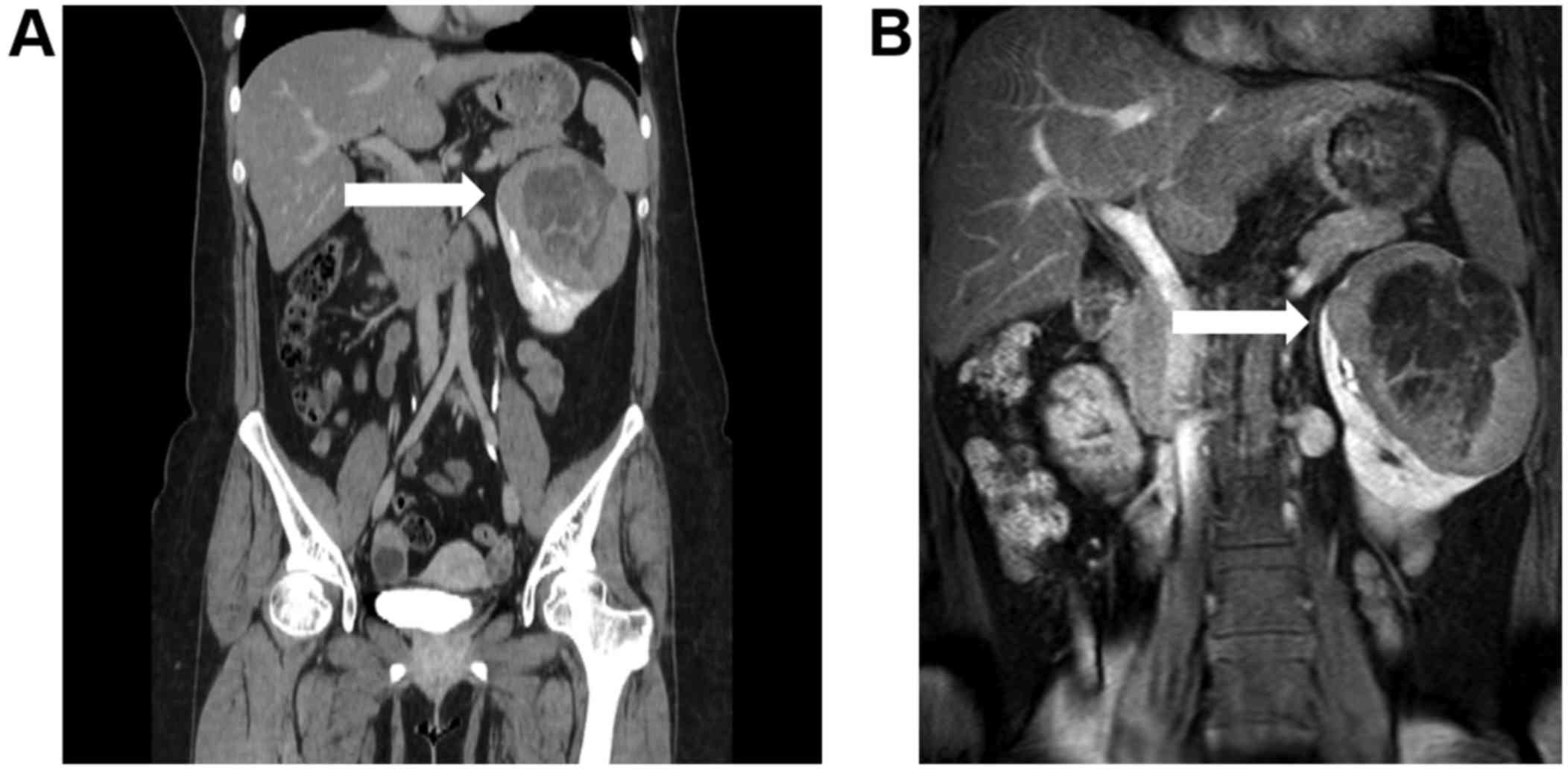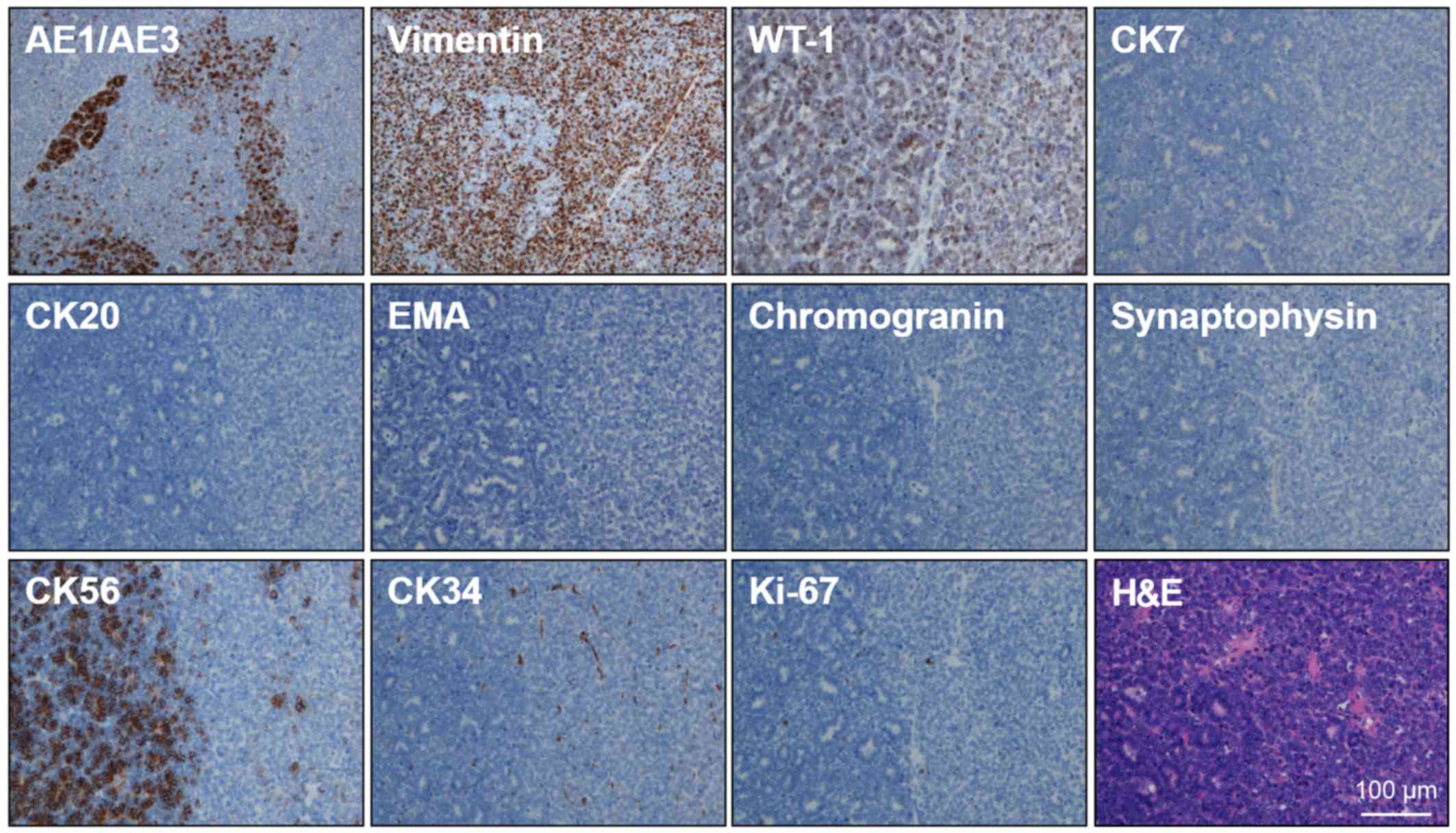Metanephric adenoma treated with laparoscopic nephrectomy: A case report
- Authors:
- Published online on: July 18, 2017 https://doi.org/10.3892/mco.2017.1327
- Pages: 404-406
Abstract
Introduction
Metanephric adenoma is a rare benign neoplasm of the kidney that occurs predominantly in middle-aged women, with few cases reported in childhood (1). Only 0.2% of adult renal epithelial neoplasms are diagnosed as metanephric adenoma (2).
Histogenetically, this lesion resembles epithelial Wilms' tumor; metanephros, which is formed from the ureteric bud and the metanephric blastema, is of mesodermal origin, and metanephric adenoma and Wilms' tumor are both derived from remnants of the metanephric blastema (1). Thus, from a clinical and diagnostic perspective, metanephric adenoma must be differentiated from Wilms' tumor, oncocytoma and papillary renal cell carcinoma (RCC).
The preoperative diagnosis of this benign tumor based on radiological findings is typically difficult; however, accurate diagnosis is of great importance as it may avoid unnecessary radical surgery (1). In the present study, in order to further the understanding of the characteristics of metanephric adenoma, a case is described along with its immunohistochemical and radiographic findings.
Case report
A 21-year-old woman with past history of thyroid tumor presented to the Department of Urology at Kanazawa University Hospital (Kanazawa, Japan) in May 2014 with a complaint of left lower back pain. There were no significant findings on physical examination. The results of the urinalysis, blood test and chest X-ray were normal.
Abdominal computed tomography (CT) and magnetic resonance imaging (MRI) revealed a large, round tumor occupying the upper and middle regions of the left kidney (Fig. 1A and B). The tumor was not clearly enhanced in the early contrast phase on CT imaging. There were no significant findings on bone scintigraphy. The preoperative diagnosis was papillary RCC, and a laparoscopic left nephrectomy was performed, with 294 min of the operation time and 50 ml of total bleeding.
Macroscopically, the tumor contained white and yellow regions, and measured 115×100×60 mm (Fig. 2A). On hematoxylin-eosin staining, the number of epithelial cells with scant acidophilic cytoplasm was increased compared with that of normal kidney tissue, and these epithelial cells formed the tubular structures (Fig. 2B). These histological features were not consistent with RCC. Immunohistochemical staining revealed positive immunoreactivity for vimentin and Wilms' tumor 1, whereas cytokeratin (CK) AE1/AE3, CK56, and CK34 were partially positive. CK7, CK20, epithelial membrane antigen, chromogranin A and synaptophysin were negative, and there were very few Ki-67 positive cells (0.2%; Fig. 3). These findings were consistent with metanephric adenoma.
A follow-up CT scan was performed 1 year after surgery, and revealed no local recurrence or metastasis.
Discussion
Metanephric adenoma is a rare neoplasm that accounts for 0.2% of adult renal epithelial neoplasms (2). Davis et al (3) reported the largest series of 50 cases of metanephric adenoma, which included patients ranging in age from 5 to 83 years (median, 44 years). There was a distinct female preponderance, with an approximate female:male ratio of 2:1. Almost 50% of the cases were asymptomatic and identified incidentally. The most common presenting symptoms were abdominal pain and hematuria. The mean tumor size was 5.5 cm, with a range of 0.3–15.0 cm (3).
From a clinical and diagnostic perspective, metanephric adenoma must be differentiated from Wilms' tumor, oncocytoma and papillary RCC. Radiologically, metanephric adenoma shows hypovascularity on contrast-enhanced CT; however, Wilms' tumor and papillary RCC exhibit similar features (3). On T2-weighted MRI, metanephric adenoma often exhibits low-intensity signals, which is also similar to the findings of papillary RCC. Thus, radiological examination is not sufficient to allow a diagnosis of metanephric adenoma, as demonstrated in the present case.
The difficulty of diagnosing metanephric adenoma prior to surgery is also due to the extremely low frequency of its occurrence (4). However, preoperative diagnosis is important to avoid excessive treatment, such as neoadjuvant therapy. Although two previous studies reported that needle biopsy could aid in diagnosing metanephric adenoma (4), nephrectomy was performed in the majority of previously reported cases as the entity could not be distinguished from a malignant tumor (5). In order to increase the rate of accurate diagnosis of metanephric adenoma, it should be considered in the differential diagnosis of renal masses, particularly in patients who are female and middle-aged, and have hypovascular tumors with clear borders.
The majority of metanephric adenomas are diagnosed following radical nephrectomy (5). However, radical nephrectomy may be unnecessary for patients with this disease as it is known to be a benign tumor. A previous study reported the case of an 11-year-old patient with a mixed tumor, which consisted of metanephric adenoma containing foci of Wilms' tumor or papillary RCC (6). In that case, metastasis was observed subsequent to surgery. In addition, a previous case report of pure metanephric adenoma in a child described the occurrence of lymph node metastasis subsequent to surgery (7). To the best of our knowledge, no previous study has reported the occurrence of metastasis in an adult patient with metanephric adenoma. However, the possibility of metastasis cannot be excluded, and surgical treatment may be required, particularly in cases involving large tumors, as large tumors have a greater probability than small tumors of containing mixed pathological tissues. In cases of small, hypovascular tumors occurring in middle-aged women, needle biopsy may be appropriate, and this may be also be necessary if the patient is unfit to undergo radical nephrectomy due to advanced age or renal dysfunction.
In summary, the present study reports a case of metanephric adenoma that was treated by laparoscopic nephrectomy. Although metanephric adenoma is difficult to diagnose preoperatively, this rare disease must be considered in order to avoid unnecessary surgical procedures in these patients.
References
|
Pasricha S, Gandhi JS, Gupta G, Mehta A and Beg S: Bilateral, multicenteric metanephric adenoma associated with Wilms' tumor in a child: A rare presentation with important diagnostic and therapeutic implications. Int J Urol. 19:1114–1117. 2012. View Article : Google Scholar : PubMed/NCBI | |
|
Hwang SS and Choi YJ: Metanephric adenoma of the kidney: Case report. Abdom Imaging. 29:309–311. 2004. View Article : Google Scholar : PubMed/NCBI | |
|
Davis CJ Jr, Barton JH, Sesterhenn IA and Mostofi FK: Metanephric adenoma. Clinicopathological study of fifty patients. Am J Surg Pathol. 19:1101–1114. 1995. View Article : Google Scholar : PubMed/NCBI | |
|
Terao H, Matsumoto T, Umemoto S, Onuki T, Kobayashi K, Ohgo Y, Nogcchi S, Kishi H, Tsuura Y and Nagashima Y: Metanephric adenoma: Report of two cases. Hinyokika Kiyo. 54:599–602. 2008.PubMed/NCBI | |
|
Ebine T, Ohara R, Momma T, Saito S and Kuramochi S: Metanephric adenoma treated with laparoscopic nephrectomy. Int J Urol. 11:232–234. 2004. View Article : Google Scholar : PubMed/NCBI | |
|
Drut R, Drut RM and Ortolani C: Metastatic metanephric adenoma with foci of papillary carcinoma in a child: a combined histologic, immunohistochemical, and FISH study. Int J Surg Pathol. 9:241–247. 2001. View Article : Google Scholar : PubMed/NCBI | |
|
Renshaw AA, Freyer DR and Hammers YA: Metastatic metanephric adenoma in a child. Am J Surg Pathol. 24:570–574. 2000. View Article : Google Scholar : PubMed/NCBI |












